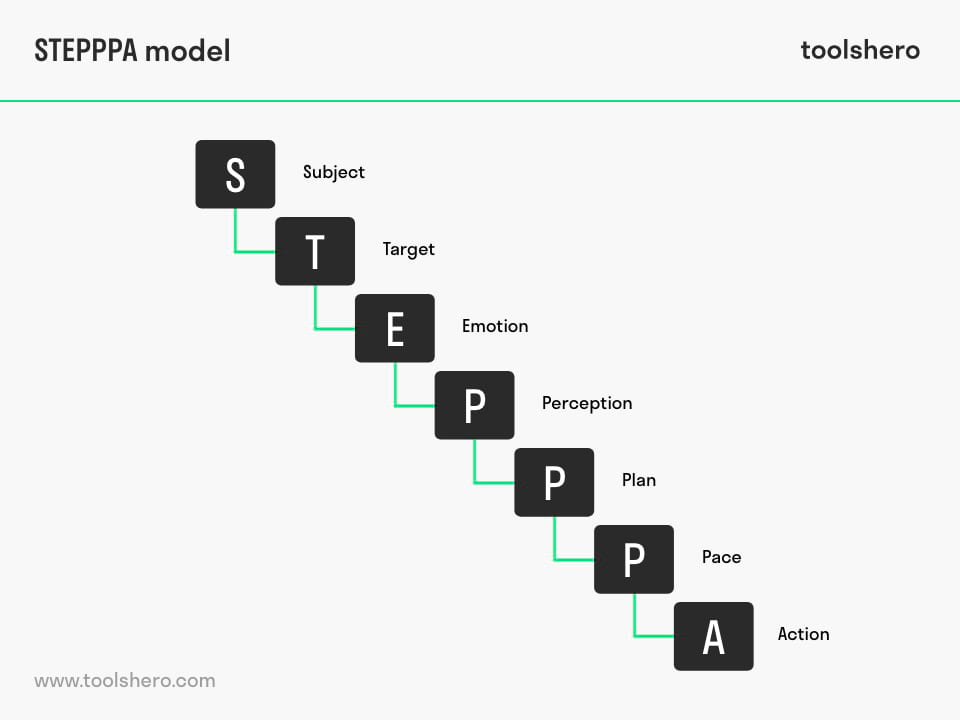STEPPA Coaching Model explained

STEPPA Coaching Model: this article contains a practical explanation of the STEPPA Coaching Model, developed by Angus McLeod. After reading, you will understand the basic concepts of this coaching model in which the importance of emotions to achieve new objectives is the basis. This model is also applied in problem solving situations.
What is the STEPPA Coaching Model?
The STEPPA Coaching Model is a mentoring and coaching model developed by the coach and counsellor Angus McLeod. It is a model that uses the emotions that may arise, because of a problem or different situation in the business environment, to focus on new goals and improvements for the achievement of success.
This tool is commonly used when it is necessary to overcome a difficult moment in which there are many emotions that influence the overcoming and improvement of that particular moment.
For the process of achieving the objectives you want to reach, one must take into account the importance of the coach for the motivation and the drive of the team or the clients to achieve what they want. In this model, all these accompaniment and training processes revolve around emotions as the motor for achieving goals and the motivation that the people involved must feel.
STEPPA Coaching Model: Emotions as a fundamental part
Emotions and the handling of them are a key factor in motivation. A motivated person can achieve the objectives that are wanted, however, a de-motivated person can lead to chaos and the non-fulfilment of goals.
That is why emotions are fundamental for motivation and performance to be achieved with that motivation. The coach is then the guide to help maintain motivation as a balance for the achievement of the goals set by the team.
The coach helps to generate or modify the goals and make them achievable.
Also a coach who has control and knows how to use emotions in a positive way can bring advantages in the training and company he gives to the client or the team since the advice and help is a feedback dynamic that people in certain moments need when they want to achieve success.
With good management of emotions, these will not be overwhelmed as the coach will help to process them in the best way and be able to continue with the processes to achieve the objectives.
The STEPPA Coaching Model is organised in an acronym, each letter meaning a step that the coach must take with the client in order to best deal with the situation or project that he wants to do.
- S – Subject
- T – Target identification
- E – Emotion
- P – Perception and choice
- P – Plan
- P – Pace
- A – Adapt or Action

Figure 1 – the steps of the STEPPA Coaching Model
Subject
In this context, the developer of this model talks about what the client wants to focus on during the coaching process and what results he or she would like to have at the end of the experience.
It is necessary for the coach to know the context of the situation being experienced by the client or the team. Knowing the important issues at the beginning of a conversation is vital for the coach to be able to guide the conversation in the best way.
The emotions related to the issue at hand are a factor in this step as the handling of emotions must be subtle and appropriate for the coach to deal with the client as emotions can provide a negative environment if they are not controlled.
Understanding and attention are also important factors on the part of the coach when discussing or conducting a conversation with the client.
Target Identification
It is necessary to identify the objective in order to achieve what is needed and desired. For this the coach must set the objectives, identify them and put into practice a plan of action for the fulfilment of the agreed objectives.
In this process the SMART method (Specific, Measurable, Timely, Realistic and Accurate) can be used to organise the objectives and achieve the goals so that they are achievable with the situation at hand.
To be able to decide on the goals and start the process, the coach must talk to the client to know what they want to achieve and how far they want to go. The objectives must be realistic and motivating in order to work in the best way and achieve success in reaching them and fulfilling the agreement.
Emotion
Emotions are a motivator or demotivator for the client as they can affect the achievement of objectives either negatively or positively.
Emotions, if used to advantage, are an impulse for motivation to achieve goals. The coach can help to guide and interpret the emotions that arise in order to achieve the objectives.
It must be taken into account that, if there is no control of the emotions, they can lead to negative moments and even blockages for the achievement of success.
The coach is then in this step an important guide to be able to manage the emotions and to take them to the rhythm of the fulfilment and process of what is desired. The coach must read the emotions in order to help the client to control and process the emotions in the best way.
Not all coaches have the ability to deal with the client’s emotions to use them to their advantage in training. Many coaches make interventions such as talks and follow-ups to each member involved in order to generate a balance between emotions and responsibilities with the project you are working on.
Perception and choice
In this stage of perception and choice in the STEPPA Model, the coach broadens the panorama of perception to the client for the changes that are to be made. The coach will not decide but will guide the client to decide on the best options to reach the goal.
Then in this step they look for the best alternatives to be able to reach the objectives. The coach will ask the right questions to be able to broaden the picture, think and be creative in order to act.
We also understand better what the client wants and how he feels in the moment to work towards the goals and achieve what he wants on a personal or professional level.
Plan and Pace
When the objectives are met, it is necessary to proceed with the creation of the step-by-step plan. The coach should be there to support and guide the client without detracting from the importance or value of the decisions made by the client in the plan before implementing it.
In this step it is important to identify, evaluate and make concrete decisions to generate actions. The strategies used in the plan must be achievable in order to achieve the proposed goals.
The plan can be supported by a time line to achieve success as key dates and moments can better visualize the goals and fulfil the planned scheme.
Adapt or Action
When the plan is reviewed, the coach and the client are ready to act. The motivation in this step becomes important again, because the attention and positive emotions of those involved can be aligned with the achievement of the proposed goals.
By adapting the plan and making the decisions that will lead to success, the accompaniment in this step is valued by the client. Also before executing what has been organised, the coach and the client make a deep reflection of everything that has been done, with this a review is made and finally actions can be taken to comply with everything that was discussed and planned in the STEPPA Model process.
STEPPA Coaching Model summary
The STEPPA Coaching Model focuses on people’s emotions and how these emotions can be used as an advantage to meet objectives and achieve success. To be able to control emotions which is the central part of this method the coach has an important role as a guide and advisor.
The coach is the person who guides the team to meet the objectives by following the key steps to achieve them. These steps include knowing what is going on and when it is happening, identifying the objectives and what is needed to start the process, the emotion as a balance of motivation for the work, choosing to make the best decisions, planning to carry out the model step by step as best as possible, taking actions to achieve the proposed goals.
The STEPPA Coaching Model is used in most cases in moments of crisis or conflict that arise in a new project or situation in which you want or are working and need a problem solving to be able to improve in the process. This not only helps to solve conflicts in a systematic way, but also helps the people involved.
The STEPPA Coaching Model is not only a model for achieving results, but also emphasizes the importance of the client’s role in achieving those results. The client’s role is guided by the coach who helps to empower the motivating emotions in order to work in the best way.
Emotions influence the work that the person does on a daily basis and how these emotions can result in success or failure to achieve what is desired. This model highlights the emotional side as a key factor when it comes to organising objectives and achieving goals.
Thus, based on emotion, the STEPPA Coaching Model develops its strategy in coaching to achieve success and also to humanise the processes, where motivation arises from the emotion that the person feels in order to set in motion what he or she wants to achieve.
Before being able to identify, measure, analyse, evaluate and decide, the people involved must have something to encourage them to achieve what they want. With the help of the coach this can be channelled and used to motivate, guide and accompany the client in the process of this model.
It’s your turn
What do you think? Is it important to use emotions as an advantage to achieve goals? Does the coach in the STEPPA Model help to balance emotions, do you think the role of the coach as a counsellor is important? Are the steps provided by the model helpful to maintain order in the fulfilment of objectives? Have you put the STEPPA Model as a tool for coaching? Have you implemented this model in your company, if so, please share with us what results it gave? Do you have anything else to add or any suggestions you would like to share?
Share your experience and knowledge in the comments box below.
More information
- Garvey, R., Strokes, P., & Megginson, D. (2010). Coaching and mentoring: Theory and practice.
- Fletcher, S., & Mullen, C. A. (Eds.). (2012). Sage handbook of mentoring and coaching in education, SAGE Publishing.
- Hopkins-Thompson, P. A. (2000). Colleagues helping colleagues: Mentoring and coaching. NASSP bulletin, 84(617), 29-36.
- Brockbank, A. (2006). Facilitating reflective learning through mentoring and coaching. Kogan Page Publishers.
How to cite this article:
Ospina Avendano, D. (2021). STEPPA Coaching Model. Retrieved [insert date] from Toolshero: https://www.toolshero.com/management/steppa-coaching-model/
Original publication date: 01/05/2021 | Last update: 09/27/2023
Add a link to this page on your website:
<a href=”https://www.toolshero.com/management/steppa-coaching-model/”>Toolshero: STEPPA Coaching Model</a>












